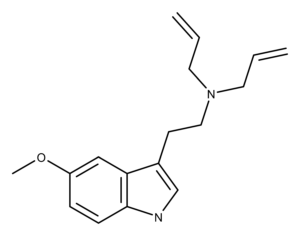5-MeO-DALT is a synthetic tryptamine analog of 5-MeO-DMT (O-methylbufotenine), a compound found naturally in toad secretions.1
The Chemistry of 5-MeO-DALT
5-MeO-DALT was first synthesized by Alexander and Ann Shulgin.2 The crystal structure of the freebase of 5-MeO-DALT was solved by Chadeayne et al. in 2020.3
The Pharmacology of 5-MeO-DALT
From their self-testing of 20 mg of the compound, the Shulgin’s commented, “The rapid onset and rapid drop-off of 5-MeO-DALT is remarkable. With oral administration, it is common to be aware of the effects in less than 15 minutes and to be fully there at the half-hour point.” 2
A 2018 study by Klein et al. found that 5-MeO-DALT induced the head twitch response (HTR) in mice.4 As such, these results indicate it has psychedelic effects that are mediated via the serotonin 5-HT2A receptor. The table below shows the serotonin receptor binding data from studies on cloned human receptors done by Klein et al.4
In 2015, Michely et al. analyzed the metabolites in the urine of rats that were given 5-MeO-DALT.5 They identified the metabolites using liquid chromatography-high-resolution mass spectrometry (LC-HR-MS-MS). Based on the metabolites they identified, the authors summarized that “…several aromatic and aliphatic hydroxylations, N-dealkylation, N-oxidation, and combinations thereof are proposed as the main metabolic pathways…” They also observed an O-demethylation product of 5-MeO-DALT. The authors also identified the main cytochrome P450 enzymes involved in the metabolism of 5-MeO-DALT. These were, CYP1A2, CYP2C19, CYP2D6, and CYP3A4.
The Applications and Potential of 5-MeO-DALT
The crystal structure of the freebase form of 5-MeO-DALT that was solved by Chadeayne et al. is essential to understanding its physical properties and for studying its activity at receptors by using modeling studies. Although it is a synthetic compound, further study of 5-MeO-DALT could help shed light on the pharmacology involved in the effects of ingesting toad secretions.
Receptor Binding Affinity Data
| Receptor | Ki (nM) | Species | Note | Ref. |
|---|---|---|---|---|
| 5-HT1A | 19 | Human | 4 | |
| 5-HT1B | 735 | Human | 4 | |
| 5-HT1D | 107 | Human | 4 | |
| 5-HT1E | 500 | Human | 4 | |
| 5-HT2A | 218 | Human | 4 | |
| 5-HT2B | 59 | Human | 4 | |
| 5-HT2C | 456 | Human | 4 | |
| 5-HT5A | 3312 | Human | 4 | |
| 5-HT6 | 153 | Human | 4 | |
| 5-HT7 | 90 | Human | 4 |
